You’ll find over 2,100 native plant species thriving across New Hampshire’s diverse ecosystems, from coastal marshes to mountain peaks. These hardy survivors have adapted to the state’s challenging four-season climate, offering you stunning options that’ll outperform most imported alternatives. While some gardeners chase exotic specimens, you’re missing spectacular opportunities right in your backyard. The secret lies in understanding which native treasures match your specific growing conditions.
Contents
- 1 New Hampshire’s Soil and Climate
- 2 Wildflowers for Spring Gardens
- 3 Towering Canopy Trees for Landscapes
- 4 Native Shrubs for Layered Landscapes
- 5 Selecting the Right Native Plants for Your Garden
- 6 Frequently Asked Questions
- 6.1 Where Can I Buy Native New Hampshire Plants Locally?
- 6.2 How Much Do Native Plants Typically Cost Compared to Non-Natives?
- 6.3 What Wildlife Do Native New Hampshire Plants Attract to Gardens?
- 6.4 When Is the Best Time to Plant Native Species?
- 6.5 Do Native Plants Require Special Fertilizers or Organic Soil Amendments?
New Hampshire’s Soil and Climate
Understanding your soil sets the foundation for successful native plant gardening in New Hampshire. You’ll discover most soils here are moderately to strongly acidic, while ideal plant growth occurs at pH 6-7. Your landscape sits atop glacial deposits that formed rocky, nutrient-poor conditions statewide. This soil acidity actually benefits many native species that evolved here.
New Hampshire divides into two ecoregions: the warmer Northeastern Coastal Zone in the south, and the Northeast Highlands covering northern and western areas. The highlands feature frigid soils on hilly terrain, supporting northern hardwood and spruce-fir forests naturally. For detailed soil information specific to your planting area, consult the SSURGO database, which provides comprehensive soil maps and properties data to support your gardening decisions.
Wildflowers for Spring Gardens
New Hampshire’s native wildflowers offer gardeners stunning spring displays, from brief ephemeral blooms to longer-lasting perennials that support pollinators and create naturalized woodland settings. These plants have evolved with local wildlife and climate conditions, making them perfectly suited for the region’s ecosystem.
Wild Columbine (Aquilegia Canadensis)
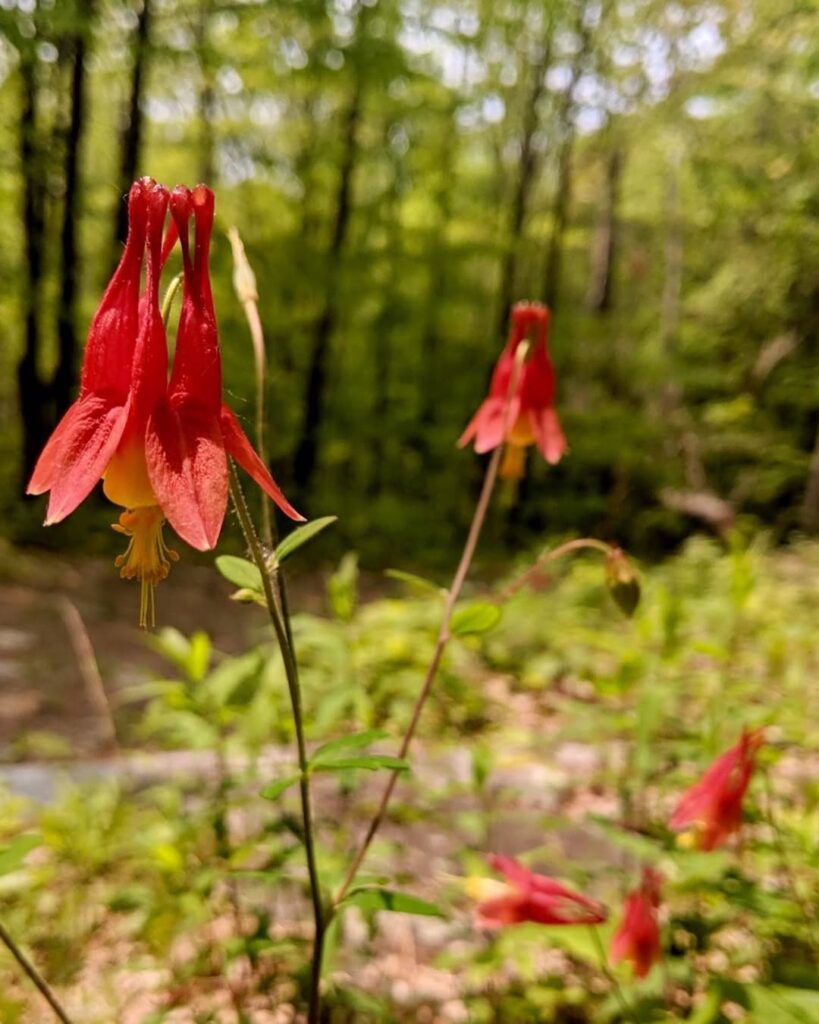
Wild Columbine (Aquilegia canadensis) is a charming native perennial that brings vibrant spring color to New Hampshire gardens. This graceful wildflower produces distinctive nodding blooms with upward-spurred petals in striking combinations of red and yellow from April through June. Reaching 2-3 feet tall with attractive blue-green compound leaves, Wild Columbine thrives in partially shaded woodland settings and rocky areas.
The species offers exceptional ecological value, providing vital early-season nectar for hummingbirds and native bees when few other flowers are available. Its unique flower structure has evolved specifically for long-tongued pollinators, making it an essential component of native plant communities. Wild Columbine readily self-seeds through wind-dispersed balloon-like seed pods, naturalizing easily in suitable locations while remaining deer resistant. The flowers transition to distinctive tan follicles containing seeds that can be collected for propagation approximately two weeks after the blooms emerge.
- Hardiness: Zones 3-8, well-suited to New Hampshire’s climate
- Light: Full shade to partial sun, prefers dappled woodland conditions
- Water: Medium to dry, drought tolerant once established
- Soil: Well-drained, prefers calcareous soils but adaptable to various types
- Fertilizer: None required, thrives in natural soil conditions
- Pest/Disease Resistance: Generally pest-free, deer resistant
- Growth Rate: Moderate, spreads naturally by self-seeding
Wild Bergamot (Monarda Fistulosa)

Wild Bergamot (Monarda fistulosa) is a striking native wildflower that brings both beauty and ecological value to New Hampshire spring gardens. This aromatic member of the mint family produces distinctive pompom-like flowers in shades of pink to lavender, creating stunning visual displays while supporting local pollinators. Also known as Bee Balm or Horse-Mint, this adaptable perennial features characteristic square stems and fragrant foliage that releases a pleasant minty scent when brushed against.
Growing up to 4 feet tall with erect branching stems, Wild Bergamot thrives in New Hampshire’s climate and readily spreads in favorable conditions. Its simple, toothed leaves arrange oppositely along hairy stems, while the summer blooms attract a variety of bees and butterflies. This native plant serves as an excellent choice for naturalized gardens, offering both ornamental appeal and valuable ecosystem services for local wildlife. Wild Bergamot has been traditionally utilized as a flavoring agent and in herbal medicine practices.
- Hardiness: Cold hardy, well-adapted to New Hampshire’s climate zones
- Light: Full sun to partial shade
- Water: Moderate water needs; drought tolerant once established
- Soil: Average, well-drained soils; adaptable to various soil types
- Fertilizer: Low fertilizer requirements; thrives in native soil conditions
- Pest/Disease Resistance: Generally resistant with good air circulation
- Growth Rate: Moderate to fast; spreads readily in favorable conditions
Trout Lily (Erythronium Americanum)
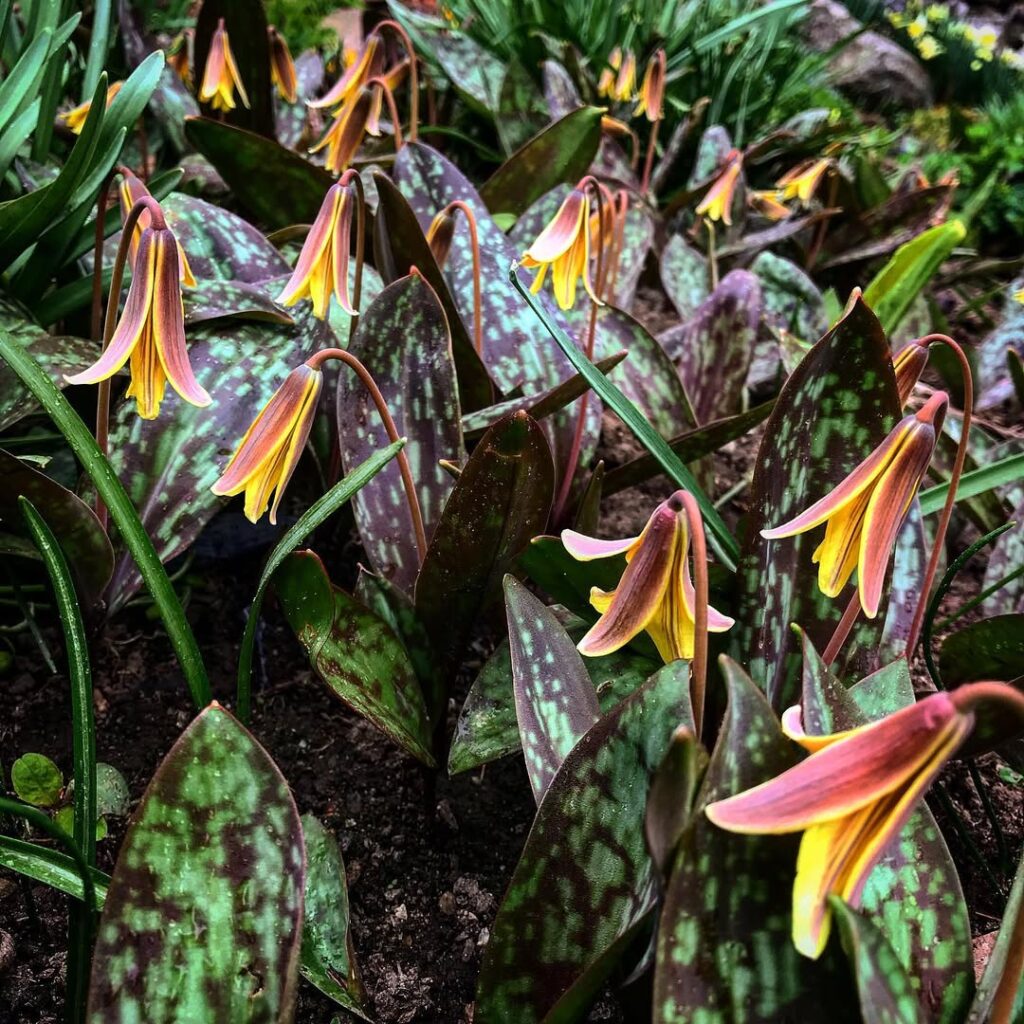
The Trout Lily (Erythronium americanum) is a charming spring ephemeral native to eastern North America, including New Hampshire. This member of the lily family produces distinctive yellow flowers with six backward-curving tepals and prominent stamens, emerging from mottled brown and green leaves that resemble trout markings. Growing 4-10 inches tall, it forms extensive colonies that can persist for centuries.
A true woodland treasure, Trout Lily requires patience as plants take 4-10 years to reach flowering maturity. Young plants produce only a single leaf, while mature two-leaved specimens are capable of blooming. The flowers attract early spring pollinators like mining bees and bumblebees, while ants help disperse the seeds. In many populations, non-flowering individuals often significantly outnumber those that produce blooms. This species thrives in naturalistic woodland gardens and restoration plantings.
- Hardiness: USDA zones 3-8
- Light: Partial to deep shade
- Water: Consistent moisture, well-drained
- Soil: Rich, organic, moist but well-draining
- Fertilizer: None needed in organic-rich soil
- Pest/Disease Resistance: Generally resistant, may be browsed by deer
- Growth Rate: Very slow, 4-10 years to flowering
Bloodroot (Sanguinaria Canadensis)

Bloodroot (Sanguinaria canadensis) is a charming native spring ephemeral that brings early season interest to New Hampshire woodland gardens. This low-growing perennial produces delicate white flowers with golden centers that emerge in early spring, rising 6-10 inches tall alongside distinctive deeply-cleft bluish-green leaves. Named for its red-orange sap and reddish rhizome, bloodroot gradually naturalizes to form impressive colonies over time.
The plant’s ephemeral nature means it blooms briefly before going dormant as summer heat arrives and tree canopies close. While flowers last only a few days, the attractive foliage persists through mid-summer before disappearing until the following spring. The emerging leaves initially provide protective cover for the developing flower buds before unfurling as the blooms appear. This native wildflower thrives in conditions that mimic its natural deciduous forest habitat.
- Hardiness: USDA zones 3-9
- Light: Shade to partial shade
- Water: Moderate moisture, mesic conditions
- Soil: Well-draining woodland soil, adaptable to various forest floor conditions
- Fertilizer: None needed when grown in appropriate woodland conditions
- Pest/Disease Resistance: Generally pest and disease free
- Growth Rate: Slow to establish, then gradually spreads via rhizomes to form colonies
Wild Ginger (Asarum Canadense)
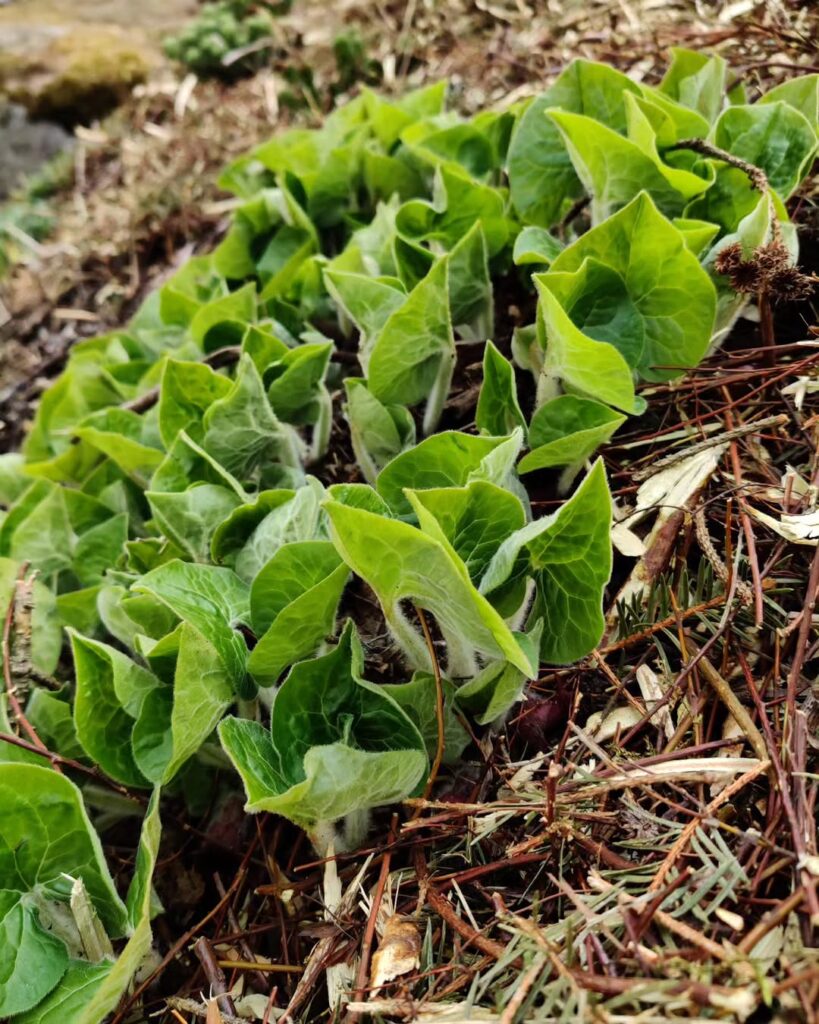
Wild Ginger (Asarum canadense) is a charming native perennial that creates excellent groundcover in New Hampshire’s woodland gardens. This low-growing plant produces distinctive heart-shaped leaves up to 6 inches wide and inconspicuous dark red flowers that bloom at ground level in early spring. Growing only 4-8 inches tall, it forms dense colonies that effectively suppress weeds while providing habitat for beneficial insects and serving as a host plant for Pipevine Swallowtail butterflies.
Once established, Wild Ginger requires minimal maintenance and offers reliable deer resistance. Its velvety foliage remains attractive throughout the growing season, making it an ideal native alternative to non-native groundcovers like hostas in shaded areas. The plant pairs beautifully with fine-leaved spring perennials such as bleeding heart and bloodroot to create diverse planting schemes in woodland gardens.
- Hardiness: USDA Zones 3-8
- Light: Partial to full shade
- Water: Moist, well-drained; tolerates dry to medium moisture once established
- Soil: Humus-rich woodland soil; tolerates clay, loam, and sandy soils
- Fertilizer: None required
- Pest/Disease Resistance: Excellent; deer resistant and relatively pest-free
- Growth Rate: Moderate; forms solid cover within 2-3 years when spaced 1 foot apart
Towering Canopy Trees for Landscapes
New Hampshire’s native canopy trees create stunning landscapes while supporting local ecosystems. From towering evergreens to vibrant maples, these species offer height, beauty, and wildlife habitat for diverse property needs. Large shrubs and small trees provide multi-season interest through their flowers, fruit, and fall foliage displays.
Sugar Maple (Acer Saccharum)
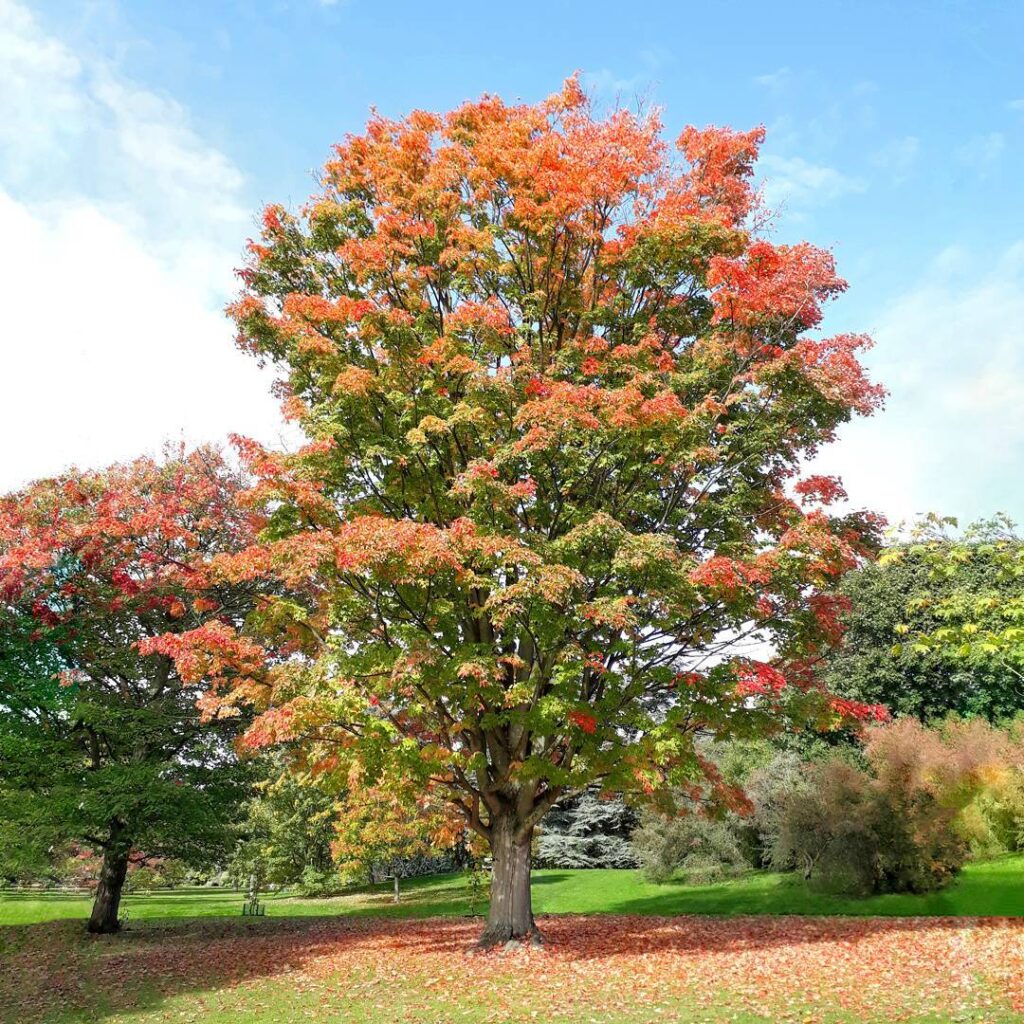
The Sugar Maple is an iconic New England canopy tree that can reach 1-2 feet in trunk diameter and live over 400 years. Known for its spectacular fall foliage in vibrant oranges, yellows, and scarlets, this majestic tree defines the New Hampshire landscape. Its extremely hard, durable wood earned it the nickname “rock maple,” with specialty grain patterns like curly and bird’s eye maple highly prized by woodworkers.
Beyond its ornamental value, Sugar Maple serves as the backbone of New Hampshire’s maple syrup industry and traditional sugaring operations. The tree’s cultural significance runs deep, representing classic New England traditions while contributing substantially to local rural economies through both syrup production and valuable lumber harvesting. This shade-tolerant species excels at regenerating in closed forest canopies, patiently waiting for gaps in the forest to accelerate its growth.
- Hardiness: Thrives in New Hampshire’s cold climate zones, tolerating harsh winters and temperature fluctuations
- Light: Full sun to partial shade, performs best with adequate sunlight exposure
- Water: Moderate moisture requirements, does not tolerate waterlogged conditions or swampy areas
- Soil: Well-drained loam soils rich in organic matter; thrives on Spodosols, Alfisols, and Mollisols
- Fertilizer: Benefits from organic matter amendments, minimal fertilization needed in suitable soils
- Pest/Disease Resistance: Generally hardy with good resistance when grown in appropriate conditions
- Growth Rate: Slow to moderate growth rate, developing strong structure over decades
White Pine (Pinus Strobus)
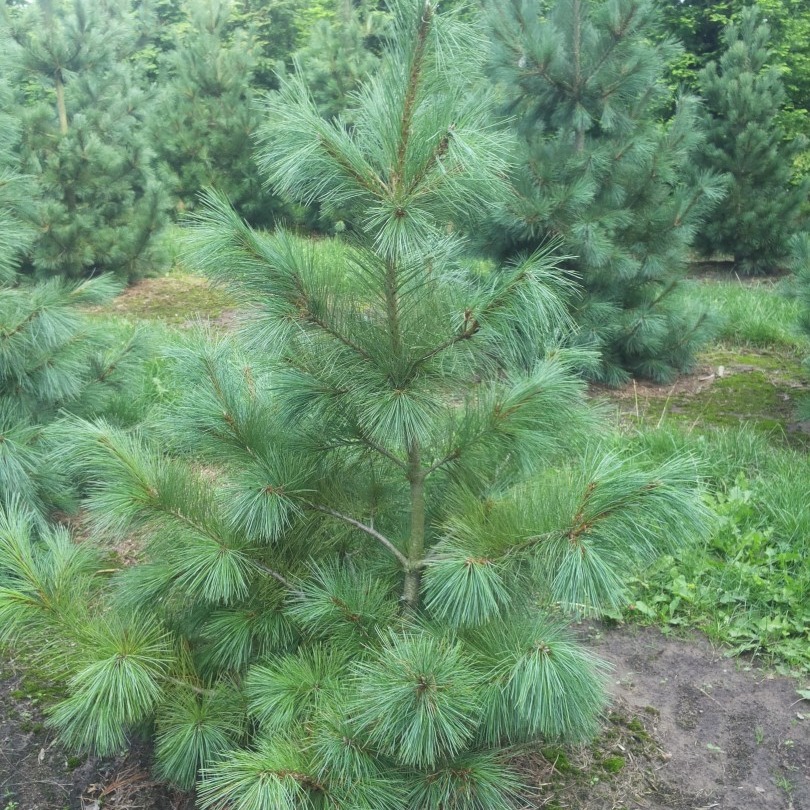
White Pine (Pinus strobus) stands as one of New Hampshire’s most iconic native conifers, capable of reaching towering heights of 30-67 meters with distinctive soft, blue-green needles arranged in clusters of five. This impressive evergreen serves as both a pioneer species and mature forest dominant, forming pure stands or mixing beautifully with hardwoods across the state’s diverse landscapes.
As a fast-growing specimen that can achieve 20 meters in 50 years, White Pine offers exceptional value for large-scale landscaping and reforestation projects. Its straight trunk, variable crown shape, and extensive root system make it ideal for providing structural interest, wildlife habitat, and soil stabilization in residential and commercial landscapes throughout New England. The species provides critical habitat for forest birds like the red crossbill and small mammals such as squirrels within its native range.
- Hardiness: Zones 3-8, thrives in New Hampshire’s climate and commonly lives 200+ years
- Light: Full sun to partial shade, adaptable to various light conditions
- Water: Moderate moisture requirements, drought tolerant once established
- Soil: Well-drained sandy or loamy soils preferred, tolerates clay and poorly drained conditions
- Fertilizer: Low maintenance, no regular fertilization required in native soils
- Pest/Disease Resistance: Susceptible to white pine blister rust, monitor for pest infestations
- Growth Rate: Fast-growing, can reach 20 meters in 50 years
American Beech (Fagus Grandifolia)
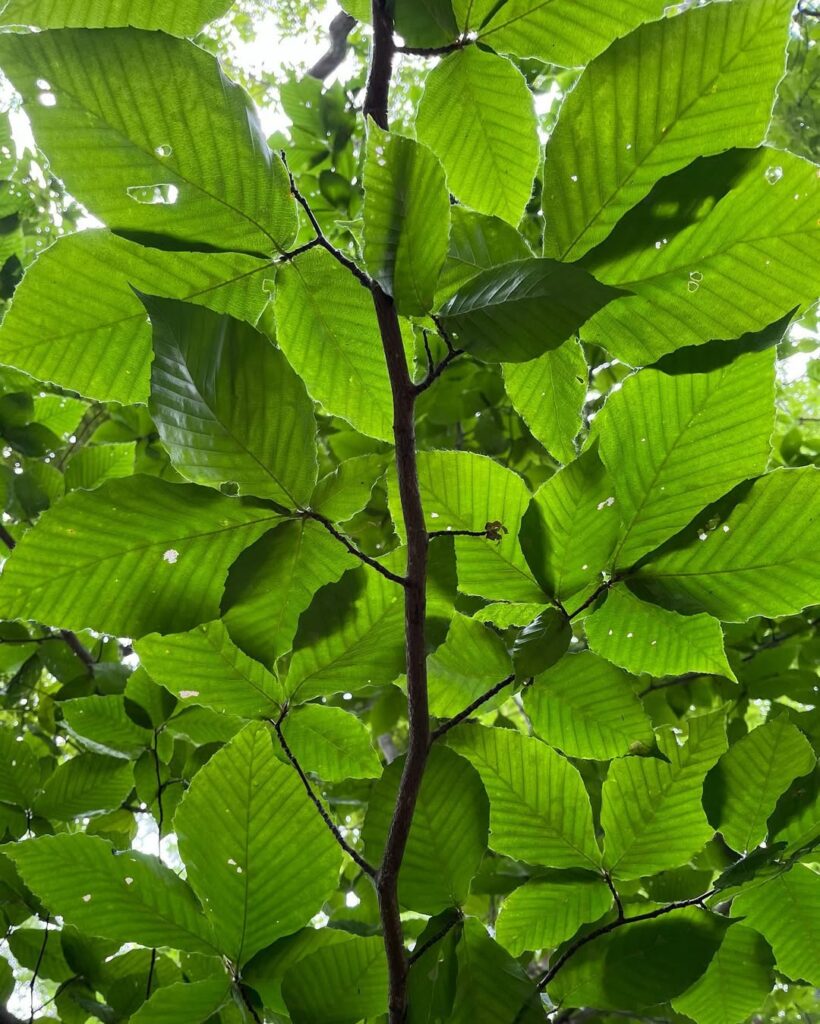
American Beech is a magnificent native canopy tree that can reach 50-80 feet tall with distinctive smooth, light gray bark that remains tight even on mature specimens. This slow-growing, long-lived species creates dense shade and produces beech nuts every 2-3 years that provide essential food for wildlife including squirrels, turkeys, and bears. The simple, toothed leaves often persist into winter, adding visual interest to the landscape.
As a specimen or shade tree, American Beech thrives in mixed hardwood forests alongside sugar maple and oak. Its aggressive surface root system helps stabilize soil but requires careful consideration when planting near pavement or other vegetation. The tree forms thickets through suckers and can dominate forest stands, particularly in northern New England settings. During mast fruiting events, the abundant beech nuts historically provided crucial sustenance for numerous bird species.
- Hardiness: USDA zones 4-9, very cold hardy
- Light: Shade-tolerant when young, full sun to partial shade at maturity
- Water: Prefers moist to wet conditions but tolerates drier sites
- Soil: Well-drained, fertile soils preferred; tolerates less fertile conditions
- Fertilizer: Low maintenance, benefits from organic matter
- Pest/Disease Resistance: Generally resistant but susceptible to beech bark disease
- Growth Rate: Slow-growing
Eastern Hemlock (Tsuga Canadensis)
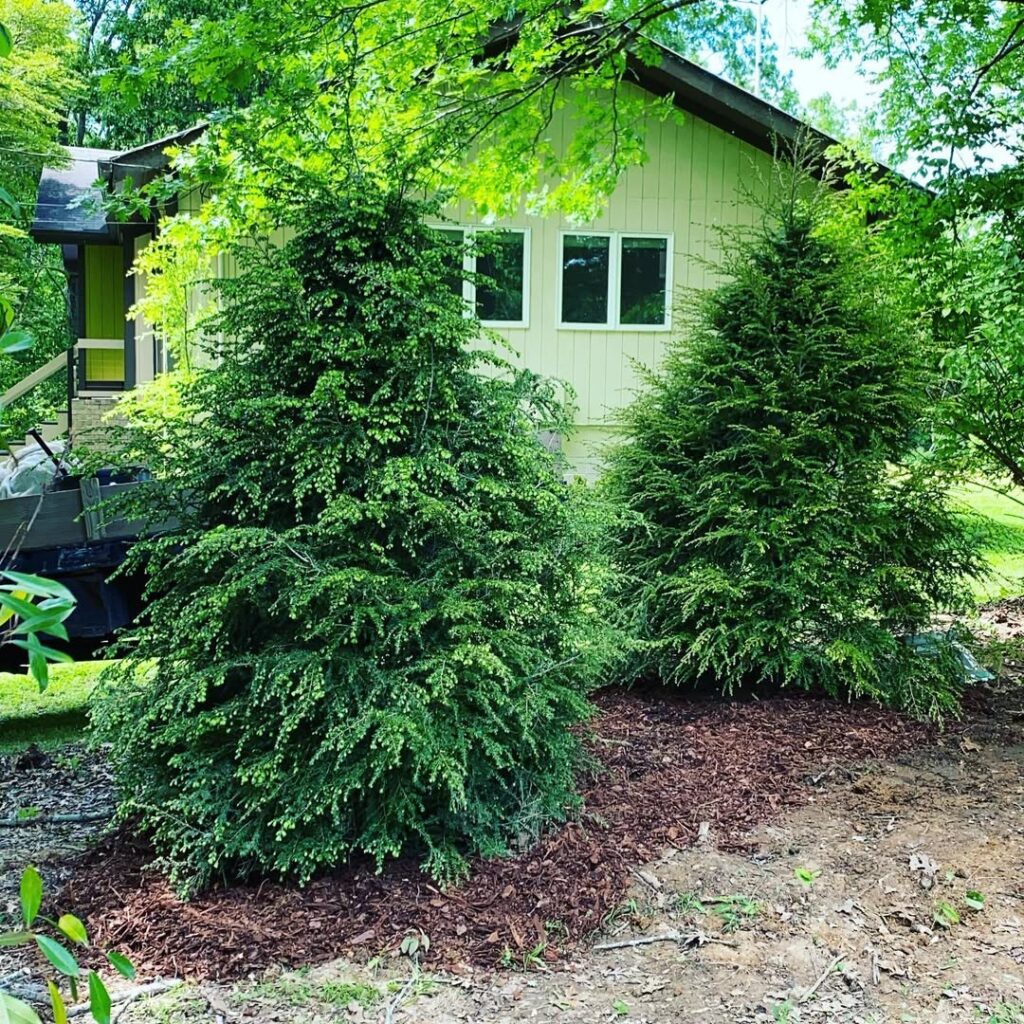
Eastern Hemlock is a majestic coniferous tree that can reach heights of 30-50 meters, creating an impressive canopy presence in New Hampshire landscapes. This graceful evergreen features distinctive drooping branch tips and short, flat needles with silvery undersides. As North America’s most shade-tolerant tree, it serves as a foundational species in cool, moist northeastern forests, providing critical habitat and regulating forest microclimates through its dense canopy.
Despite its ecological importance and landscape value, Eastern Hemlock faces significant threats, particularly from the invasive hemlock woolly adelgid. Its shallow root system makes it vulnerable to drought and wind damage, though it excels in its preferred cool, humid environments where it can persist for centuries. The tree offers exceptional wildlife value, providing winter shelter while its seeds feed red crossbills and small mammals.
- Hardiness: USDA zones 3-7, withstands cold northeastern winters
- Light: Full shade to partial shade; extremely shade-tolerant
- Water: Consistent moisture required; poor drought tolerance due to shallow roots
- Soil: Moist, well-drained, acidic soils preferred
- Fertilizer: Minimal requirements in suitable growing conditions
- Pest/Disease Resistance: Highly susceptible to hemlock woolly adelgid; vulnerable to fire damage
- Growth Rate: Slow to moderate; can persist as seedlings for decades before maturity
Red Oak (Quercus Rubra)

Northern red oak (Quercus rubra) stands as one of New Hampshire’s most majestic native trees, capable of reaching heights over 76 feet with canopy spreads extending 47 feet or more. This long-lived deciduous giant features distinctive 5-8 inch leaves with seven to eleven lobes and characteristic gray bark with shallow furrows forming broad, scaly ridges.
As a fundamental species of New England’s mixed oak forests, red oak provides exceptional landscape value through its broad shade canopy, striking fall colors, and year-round visual interest. The species offers both ecological benefits as wildlife habitat and economic value as a source of premium hardwood lumber, making it an excellent choice for large-scale landscaping where substantial canopy coverage is desired. Mature red oaks develop hollow trunks that provide essential den sites for raccoons and other mammals.
- Hardiness: USDA zones 3-8, extremely cold tolerant as the most northerly oak species
- Light: Full sun to partial shade, prefers full sun for best growth
- Water: Moderate water needs, drought tolerant once established
- Soil: Deep, well-draining soils preferred, adaptable to various soil types
- Fertilizer: Low maintenance, benefits from organic matter but not requiring regular fertilization
- Pest/Disease Resistance: Generally hardy with good resistance to most common pests and diseases
- Growth Rate: Moderate to fast-growing when young, slowing with maturity
Native Shrubs for Layered Landscapes
New Hampshire’s 235+ native shrub species create effective layered landscapes through diverse heights and forms, providing key species selections, essential ecological functions, versatile design applications, and important conservation opportunities. These woody plants are defined by their multi-stem form and maximum height of 20 feet, distinguishing them from single-trunk trees in landscape design.
Elderberry (Sambucus Canadensis)
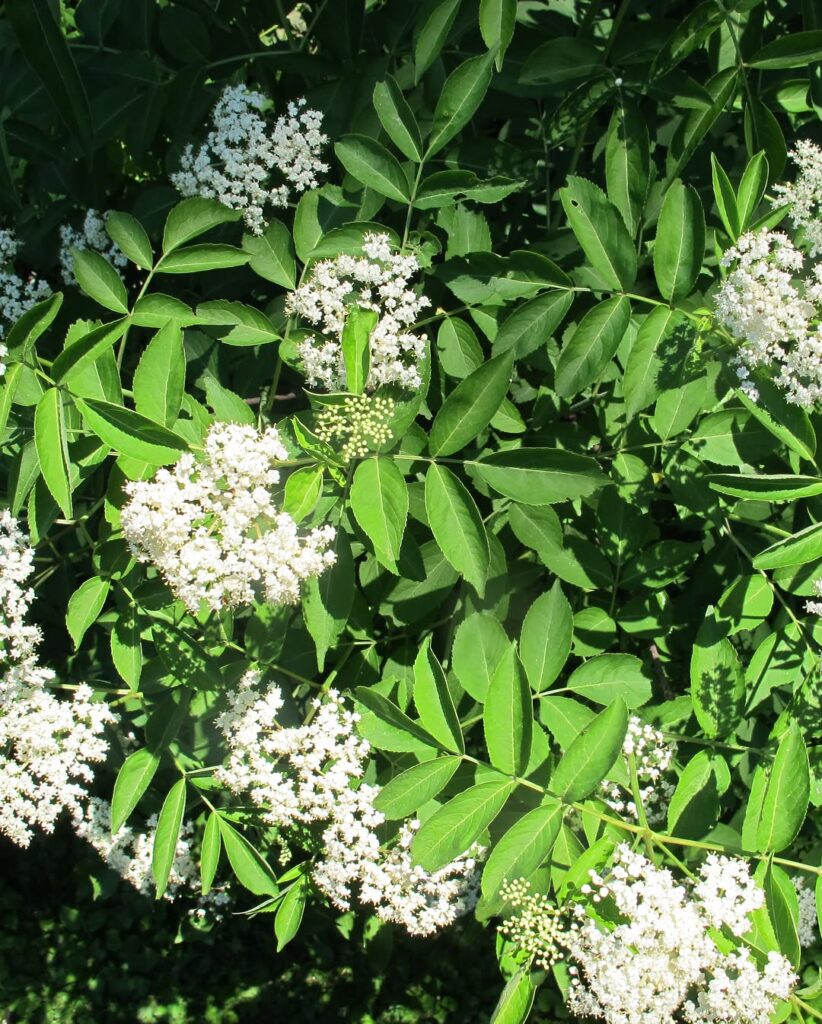
Elderberry (Sambucus canadensis) is a versatile native shrub that brings multi-season interest to New Hampshire landscapes. This deciduous woody plant grows 5-12 feet tall with an attractive arching, multi-stemmed form. Large clusters of white lacy flowers bloom in early summer, followed by dark purple-black berries in late summer that provide valuable wildlife food. The compound leaves with serrated leaflets create medium-textured foliage that complements the plant’s rounded, spreading habit.
As a native species found throughout New Hampshire’s diverse regions, elderberry thrives in various landscape conditions from full sun to partial shade. Its adaptability to different soil types and moisture levels makes it an excellent choice for naturalized areas, wildlife gardens, or mixed shrub borders where its layered structure adds depth and seasonal appeal. The edible fruit can be harvested for use in pies, pancakes, jellies, and winemaking.
- Hardiness: USDA zones 4a-8b
- Light: Full sun to partial shade (2-6+ hours direct sunlight)
- Water: Prefers moist conditions but tolerates well-drained soil
- Soil: Adaptable to clay, sand, loam, and high organic matter; acidic to neutral pH (6.0-8.0)
- Fertilizer: Low requirements as native species
- Pest/Disease Resistance: Generally resistant with few serious issues
- Growth Rate: Medium growth rate
Spicebush (Lindera Benzoin)
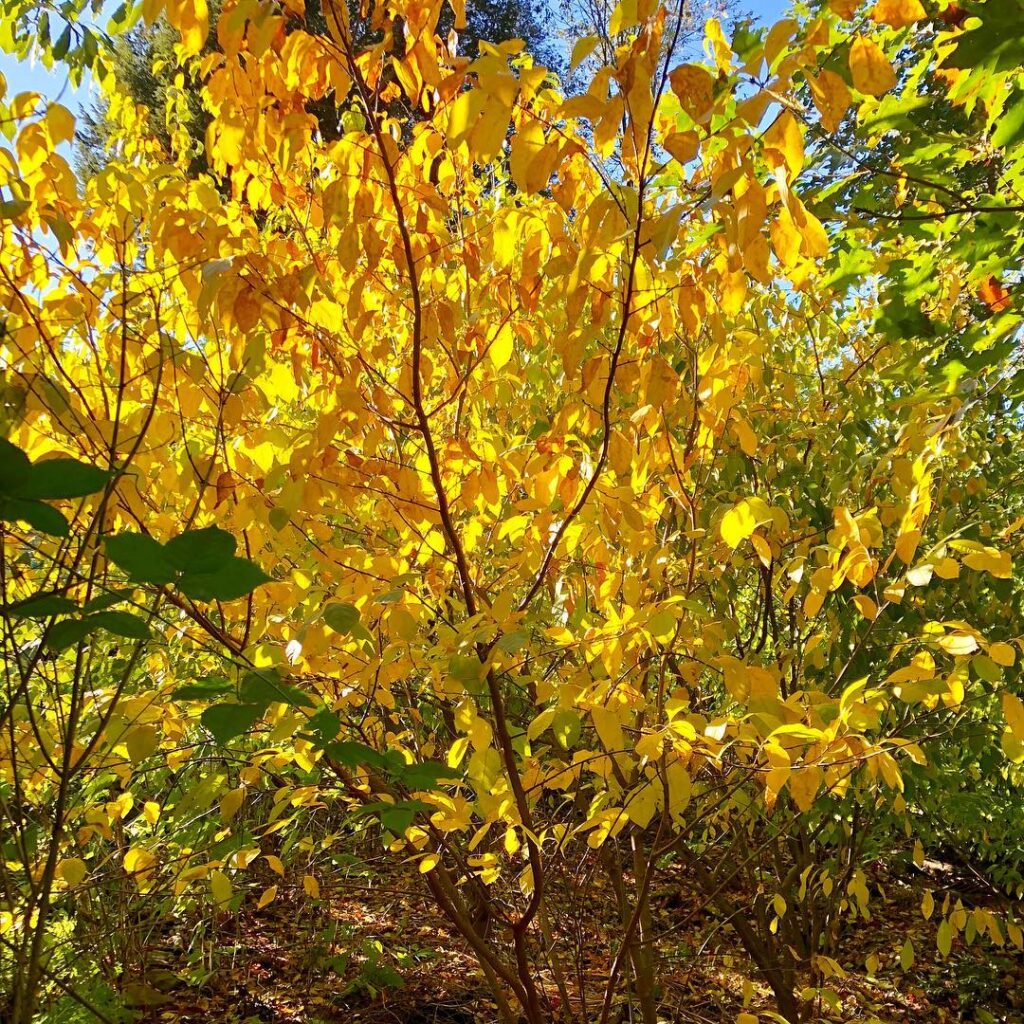
Spicebush (Lindera benzoin) is a deciduous native shrub that typically grows 6-12 feet tall and wide, thriving in New Hampshire’s moist lowlands and understory environments. Often called the “forsythia of the wilds,” it produces clusters of fragrant pale yellow flowers in early spring before leaves emerge, followed by aromatic red berries in fall and brilliant golden-yellow autumn foliage.
This versatile shrub serves as a host plant for Spicebush Swallowtail butterflies while providing nectar for native pollinators and fruit for wildlife. Its glossy, obovate leaves and multi-season interest make it excellent for naturalistic landscapes, woodland gardens, and rain gardens. Both male and female plants are needed for fruit production, and the aromatic leaves and twigs can be used for herbal tea. The plant thrives particularly well in floodplain areas along rivers and streams where moisture levels remain consistently high.
- Hardiness: USDA zones 4-9
- Light: Partial shade to full shade
- Water: Moist to wet conditions; tolerates range of moisture levels
- Soil: Prefers moist, well-draining soils; tolerates various soil types
- Fertilizer: Low maintenance; typically doesn’t require supplemental fertilization
- Pest/Disease Resistance: Resistant to most common pests and diseases
- Growth Rate: Moderate growth rate once established
Serviceberry (Amelanchier Canadensis)
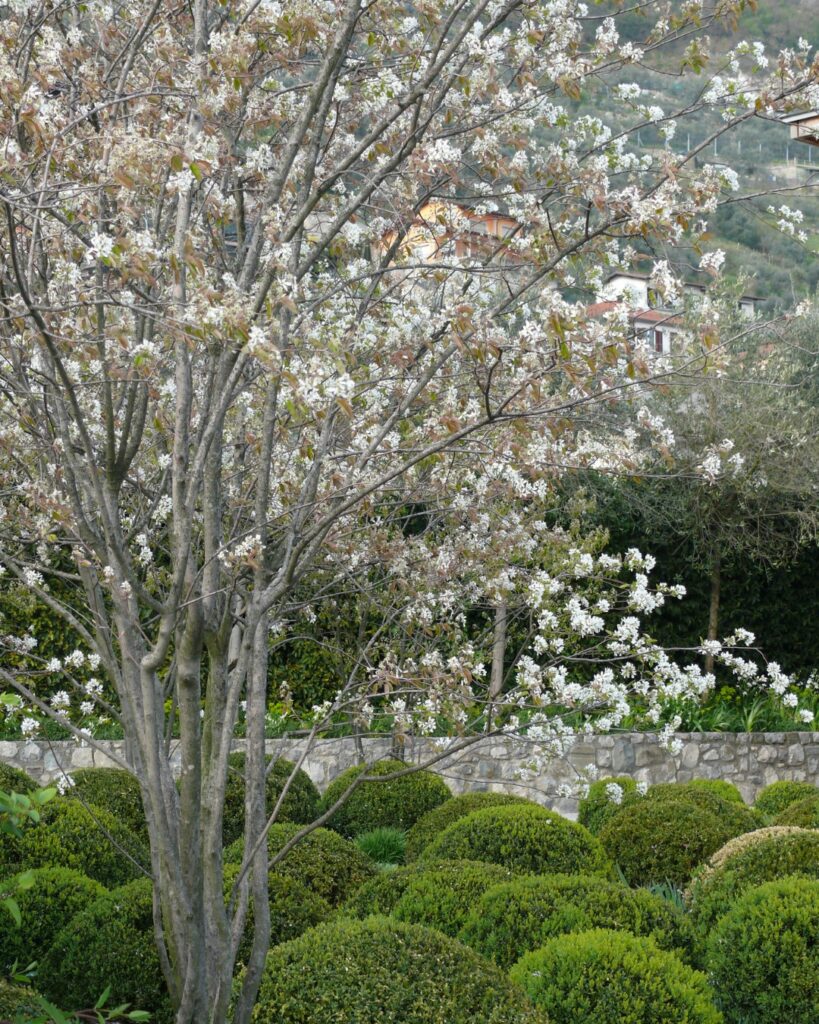
Serviceberry (Amelanchier canadensis) is a versatile native New Hampshire shrub or small tree that provides exceptional four-season interest. In late spring, it produces stunning clusters of white, five-petaled flowers that attract early pollinators, followed by sweet, edible berries that wildlife enthusiastically consume. This adaptable plant thrives in various conditions and grows 6-26 feet tall with a graceful, arching habit.
Ideal for layered landscapes, serviceberry functions beautifully as an understory plant, foundation planting, or naturalized border specimen. Its vibrant orange to rusty-red fall foliage adds seasonal drama, while the crimson-purple summer berries provide valuable food for over 40 bird species and various mammals, making it an excellent choice for wildlife-friendly gardens. The berries are rich in vitamin C and nutrients, making them historically valuable to Native Americans who used them to create pemmican, a nutrient-dense food that helped prevent scurvy.
- Hardiness: Zones 3-8, well-suited to New Hampshire climate
- Light: Full sun to partial shade; best flowering in full sun
- Water: Moderate; drought-tolerant once established
- Soil: Moist, well-drained; adaptable to various soil types
- Fertilizer: Minimal fertilization needed in nutrient-rich soils
- Pest/Disease Resistance: Moderate; susceptible to rust, leaf spot, and fire blight but damage is typically cosmetic
- Growth Rate: Moderate
Winterberry Holly (Ilex Verticillata)
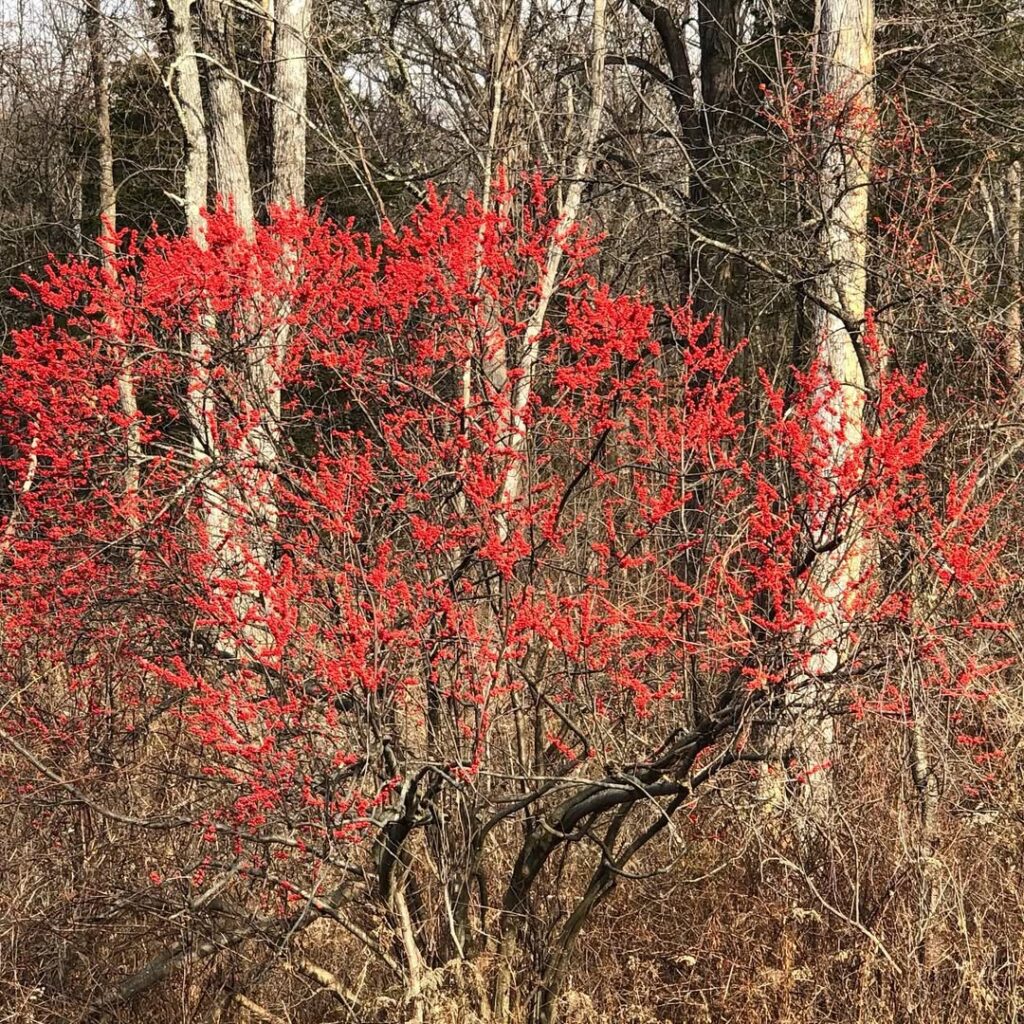
Winterberry Holly is a deciduous native shrub that brings exceptional winter interest to New Hampshire landscapes. Growing 4-10 feet tall and wide, this versatile holly produces abundant bright red berries that persist throughout winter after the dark green leaves drop in fall. Unlike evergreen hollies, winterberry lacks sharp-toothed foliage and provides a softer texture in mixed plantings.
The shrub naturally thrives in wetlands and moist areas throughout eastern United States, making it perfectly adapted to New Hampshire’s climate. Female plants produce the striking red berries that become increasingly prominent against bare winter branches, while inconspicuous white flowers appear in spring. This dioecious plant serves as both an excellent naturalizer for rain gardens and wetland areas, and provides critical winter food for birds when the berries soften after frost. The shrubs also offer valuable summer nesting cover for birds, creating important wildlife habitat throughout the growing season.
- Hardiness: USDA zones 3-9
- Light: Full sun to partial shade
- Water: Consistently moist soil preferred, but adaptable to wet or dry conditions
- Soil: Tolerates various soil types, naturally occurs in wetland soils
- Fertilizer: Low maintenance, typically does not require supplemental fertilizing
- Pest/Disease Resistance: Generally resistant to major pests and diseases
- Growth Rate: Moderate growth rate
Witch Hazel (Hamamelis Virginiana)
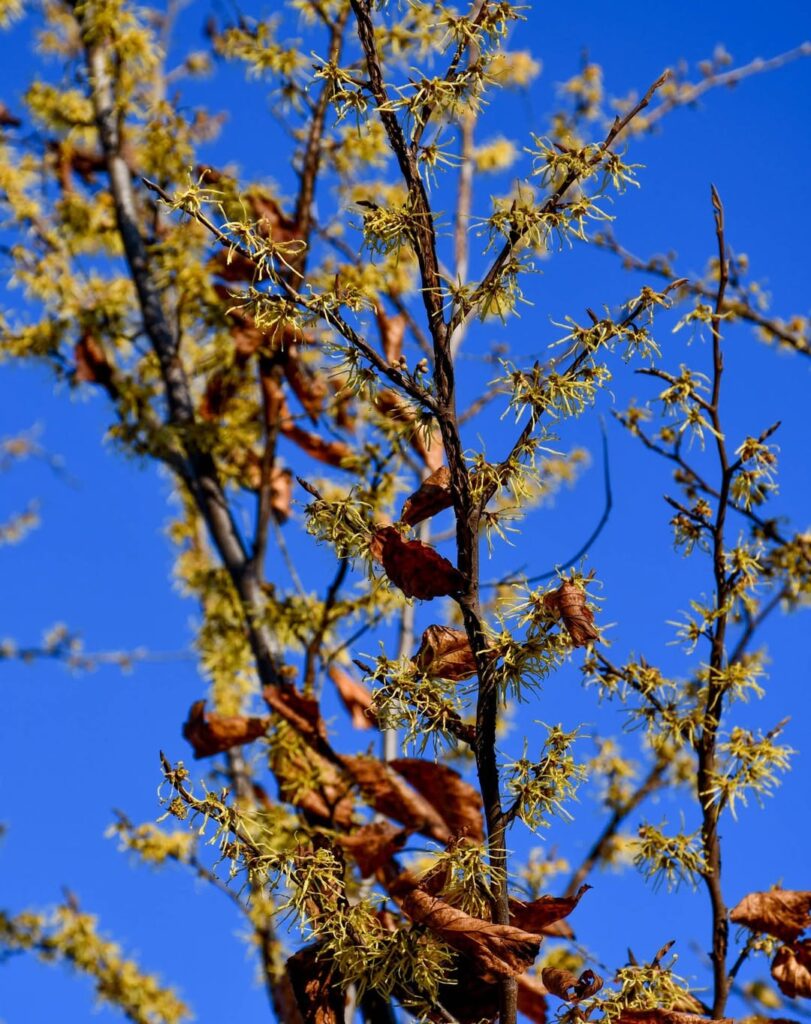
Witch Hazel (Hamamelis virginiana) is a distinctive native shrub or small tree that brings unique late-season beauty to New Hampshire landscapes. Growing 15-20 feet tall and wide, this adaptable plant produces striking crinkly yellow flowers with strap-like petals from September to November, when most other plants have finished blooming. Its open crown and crooked, spreading branches create interesting winter architecture.
This remarkable native offers exceptional ecological value, supporting 62 species of caterpillars and attracting moths as pollinators. The plant’s unusual reproductive cycle includes ballistic seed dispersal in late October, followed by a two-year germination period. Beyond its ornamental appeal, witch hazel has significant cultural importance, with bark and leaves traditionally used medicinally by Native Americans and later adopted by Puritan settlers. The smooth gray bark provides visual interest throughout the year, complementing the plant’s architectural form.
- Hardiness: Zones 3-8
- Light: Full sun to partial shade
- Water: Moderate to moist conditions; tolerates wet soils
- Soil: Adaptable to various soil types; prefers well-drained, acidic to neutral pH
- Fertilizer: Low maintenance; minimal fertilization needed
- Pest/Disease Resistance: Generally pest and disease free
- Growth Rate: Slow to moderate
Selecting the Right Native Plants for Your Garden
When choosing native plants for your New Hampshire garden, you’ll want to match each species to your specific site conditions and landscape goals. Start by evaluating your soil’s pH, drainage, and sunlight exposure. Acidic soils suit most native trees and shrubs, while moisture-loving species like marsh marigold thrive in wet areas.
Consider native garden design principles when planning your layout. Group plants with similar water and light requirements together for easier maintenance. Plant companioning works well with natives—pair boneset’s full-sun needs with other prairie species, or cluster shade-tolerant blue cohosh with ferns for woodland areas. Remember that availability changes monthly based on nursery stock levels, so plan your planting timeline accordingly and consider signing up for restock notifications on your preferred species.
Frequently Asked Questions
Where Can I Buy Native New Hampshire Plants Locally?
You can find native New Hampshire plants at local nurseries like Bagley Pond Perennials in Warner, Fassett Farm Nursery near Mount Monadnock, and Found Well Farm in Pembroke for plant sales.
How Much Do Native Plants Typically Cost Compared to Non-Natives?
Ironically, you’ll pay more upfront for native plant pricing—$12-18 per plant versus $2.50 for non-native alternatives. However, you’ll save considerably long-term through reduced watering, fertilizing, and maintenance costs.
What Wildlife Do Native New Hampshire Plants Attract to Gardens?
You’ll attract over 200 native bee species and 130 butterfly varieties to your garden. Native New Hampshire plants support songbirds, game birds, mammals, reptiles, and amphibians, creating exceptional pollinator species diversity and enhanced garden biodiversity.
When Is the Best Time to Plant Native Species?
Fall’s your best planting season for native species, with warm soil encouraging strong root development. You’ll want to think about planting zone considerations and plant before October 1st in New Hampshire for ideal establishment success.
Do Native Plants Require Special Fertilizers or Organic Soil Amendments?
Like nature’s own balanced diet, native plant care doesn’t demand fancy fertilizers since these species evolved in New Hampshire’s acidic soil. You’ll find their soil requirements are naturally met, though occasional organic amendments help.
